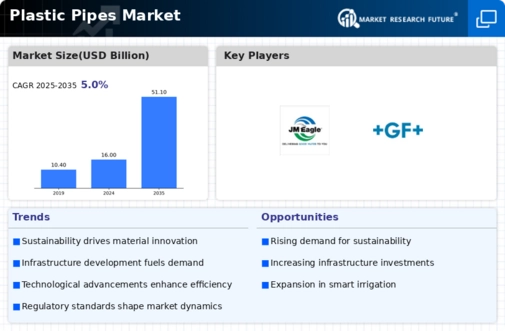Top Industry Leaders in the Plastic Pipes Market

The plastic pipes market, a silent yet ubiquitous player in our world, carries the unseen lifeblood of our infrastructure. From plumbing and construction to irrigation and industrial applications, these versatile tubes are intricately woven into the fabric of our existence. examining key strategies, factors influencing market share, industry news, and recent developments shaping its future.
Strategies Propelling the Flow:
Material Specificity and Innovation: Manufacturers are diversifying their offerings, with each plastic type (PVC, PE, PP, etc.) tailored to specific applications. Advancements like chlorinated PVC for fire resistance or polyethylene variants for chemical resilience showcase a focus on niche expertise.
Sustainability Push: Embracing the green wave, companies are investing in recycled plastics and bioplastics to reduce reliance on virgin materials. Eco-friendly production processes and life cycle assessments further demonstrate commitment to environmental responsibility.
Technological Embrace: Automation in pipe production, advanced joining techniques like electrofusion, and smart pipe technologies with integrated sensors contribute to efficiency, safety, and data-driven optimization.
Geographical Expansion and Market Penetration: Leading players are venturing into emerging markets with high infrastructure needs, while consolidating their presence in developed regions through strategic acquisitions and partnerships.
Cost-Effectiveness and Value Proposition: Finding the sweet spot between affordability and durability is crucial. Offering competitive pricing structures, bulk discounts, and tailored solutions caters to budget-conscious clients and specific project requirements.
Factors Fostering Market Dominance:
Brand Reputation and Quality: A proven track record of delivering high-quality pipes with consistent performance and adherence to international standards builds trust and attracts repeat customers.
Product Portfolio and Application Focus: Offering a diverse range of pipes for various applications broadens market reach. Specializing in specific sectors like oil and gas or water transportation can lead to niche leadership.
Production Capacity and Supply Chain Efficiency: Streamlined manufacturing processes, optimized inventory management, and reliable logistics infrastructure ensure timely delivery and minimize project delays.
Research and Development: Investing in R&D fosters innovation and allows companies to stay ahead of the curve with environmentally friendly materials, improved pipe properties, and cost-effective production methods.
Regulatory Compliance and Certifications: Adherence to safety regulations and environmental standards like NSF and ASTM demonstrates commitment to quality and responsible manufacturing.
Key Players:
-
Aliaxis Group S.A.
-
Wienerberger AG
-
Mexichem SAB de CV
-
JM Eagle, Inc.
-
ASTRAL POLYTECHNIK LIMITED
-
China Lesso Group Holdings Ltd.
-
Pipe Corporation
-
Finolex Industries Ltd.
-
Georg Fischer Ltd.
-
Hilliard among others
Recent Developments:
August 2023: Uponor introduces a new range of lightweight and flexible PE pipes ideal for complex installations and challenging environments.
September 2023: Polypipe Plc partners with a waste management company to develop a closed-loop recycling system for used PVC pipes.
October 2023: The American Society of Civil Engineers releases a report highlighting the need for increased investment in plastic pipe infrastructure replacement due to aging pipelines.
November 2023: The European Union proposes stricter regulations on the use of certain chemicals in plastic pipe production, impacting manufacturing practices and product specifications.
December 2023: A consortium of leading plastic pipe manufacturers announces plans to develop a standardized digital platform for data sharing and supply chain optimization.

